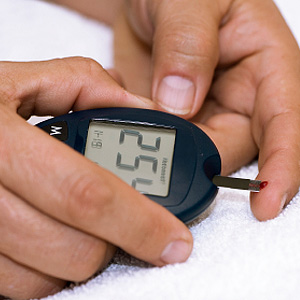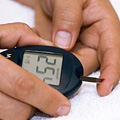Description of the test
Blood glucose testing allows people with diabetes to measure their blood glucose (sugar) levels at various times throughout the day to make sure it is within their target range and to monitor the effects of medication and lifestyle changes on their blood sugar.
Blood glucose testing is done using a blood glucose meter, which is a small portable machine that can be used at home or taken with you wherever you go. Testing strips are inserted into the meter, and the strips draw up a sample of blood into a test chamber within the meter. A chemical reaction occurs, resulting in a current that is measured by the meter to give you a reading of your blood glucose level. The level is given as a number and is measured in mmol/L or mg/dL.
The test also involves lancets (small needles used to prick the skin) and a lancet device that holds the lancet.
How often should the test be performed?
The frequency of testing depends on the type of diabetes you have and the type of medication therapy you are on. People with type 1 diabetes using insulin should test at least 3 times a day, or as often as directed by your doctor. People with type 2 diabetes using once-daily insulin and medication for their diabetes should test at least once a day. Otherwise, you should talk to your doctor about how often you should test.
Regardless of how often you test, it is important that you try to test at different times each day and do tests both before and after meals in order to get a complete picture of your blood glucose levels, but remember to take them at similar times to create a consistent picture for yourself.
Why is this test performed?
It is important for people with diabetes to monitor their blood glucose regularly so that they can make sure their levels are within a safe range. Knowing your blood glucose levels can help you prevent or respond to emergency situations such as hypoglycemia (low blood glucose), which can cause shakiness, dizziness, and even unconsciousness and death.
If you discover you have hypoglycemia, you can eat or drink something that will give you an immediate source of glucose. The results of the test can also be used to determine how much insulin you need before each meal and if you need to adjust your dose during exercise, times of stress, or illness.
Testing can also help you avoid future complications that can result if your blood glucose is regularly too high (hyperglycemia), such as kidney and eye damage, nerve damage, foot ulcers, and heart disease. If you find that your levels are consistently high, you should talk to your doctor as you may require more medication or a change in diet and lifestyle.
Are there any risks and precautions?
There aren't many risks to be worried about regarding blood glucose testing. You should always wash your hands with soap and water before pricking your skin to avoid infection. You can also prevent infection by never using a lancet more than once. To avoid getting hard spots on your fingertips from frequent testing, try to use a different finger or different pricking site each time. The prick may hurt a little but you can minimize this by pricking the side of your finger, not the tip.
What happens during the test?
Be sure to wash your hands with soap and water and dry them before the test. If the test strips come in a bottle, remove one and then put the lid back on. If the strips are stored in your meter, read the instructions on how to release one strip. If you don't test very often, check the expiry date on your strips before using them, as they can expire and cause erroneous readings. Prepare the blood glucose meter with the test strip according to the instructions.
Use the lancet device to prick the side of your fingertip with a lancet. Place a drop of blood onto the correct part of the test strip. The strip will draw up the blood into the meter. You only need a small amount of blood, and may need to adjust the depth of your lancet accordingly. Check the instructions to determine how much you will need for your specific meter. If you need more blood after pricking, use a finger from your other hand to apply slight pressure in an upwards motion toward the testing site (towards the tip of the finger) to release more blood.
There are also meters available that let you obtain a blood sample from areas other than the fingertip, such as the forearm, palm, or thigh. The accuracy of results taken from these sites may vary, with fingertip samples being the most accurate during periods in which blood glucose rapidly changes (e.g., after meals or during exercise). Blood samples that are taken from the palm (near the base of the thumb) are most closely correlated with those from the fingertip.
When finished, use a clean cotton ball to apply pressure to the testing site for a few moments until the bleeding stops. Most meters will give you a digital reading of your blood glucose level within seconds. Many will store your readings or let you download them to a computer. If not, be sure to record your results so you can discuss them with your doctor.
How should I prepare for this test?
The only thing you need to do before the test is make sure that you wash your hands with soap and water and dry them thoroughly. You can also clean the test site with alcohol.
What can I expect after the test?
You can return to your normal activities immediately after the test. If your blood glucose reading is not within your expected range, then you may need to alter the amount of insulin you take next, or eat or drink something that will give you an immediate source of glucose. Talk to your doctor about what to do when your blood glucose readings are above or below what you expect.
Results
In general, a fasting blood glucose reading (taken in the morning before a meal) should be between 4.0 mmol/L to 7.0 mmol/L (72 mg/dL to 126 mg/dL). A blood glucose reading 2 hours after a meal should be between 5.0 mmol/L to 10.0 mmol/L (90 mg/dL to 180 mg/dL).
Blood glucose testing using a blood glucose meter is available immediately. You should discuss your target blood glucose range with your doctor. Depending on your situation, your doctor may set different targets for you. Your doctor will also tell you what to do when your reading is not within your target range.
All material copyright MediResource Inc. 1996 – 2024. Terms and conditions of use. The contents herein are for informational purposes only. Always seek the advice of your physician or other qualified health provider with any questions you may have regarding a medical condition. Source: www.medbroadcast.com/procedure/getprocedure/Blood-Glucose-Testing


